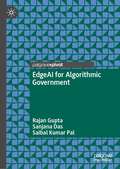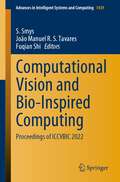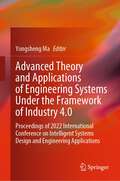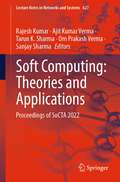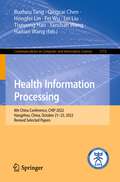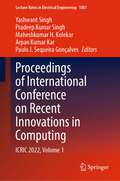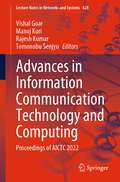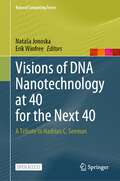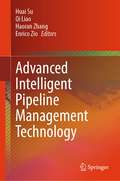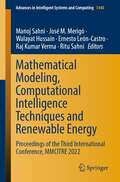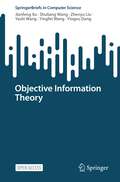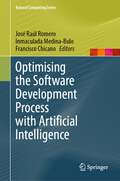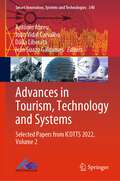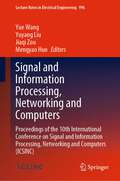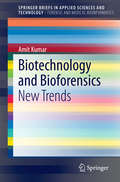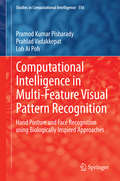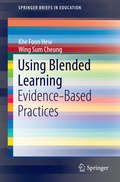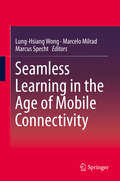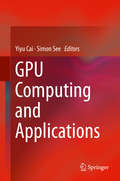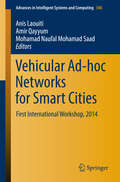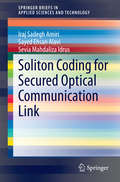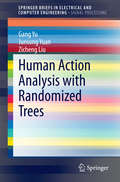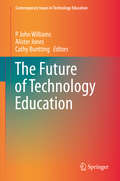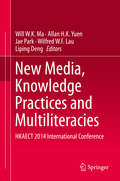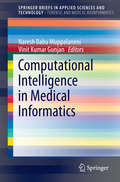- Table View
- List View
EdgeAI for Algorithmic Government
by Rajan Gupta Sanjana Das Saibal Kumar PalThe book provides various EdgeAI concepts related to its architecture, key performance indicators, and enabling technologies after introducing algorithmic government, large-scale decision-making, and computing issues in the cloud and fog. With advancements in technology, artificial intelligence has permeated our personal lives and the fields of economy, socio-culture, and politics. The integration of artificial intelligence (AI) into decision-making for public services is changing how governments operate worldwide. This book discusses how algorithms help the government in various ways, including virtual assistants for busy civil servants, automated public services, and algorithmic decision-making processes. In such cases, the implementation of algorithms will occur on a massive scale and possibly affect the lives of entire communities. The cloud-centric architecture of artificial intelligence brings out challenges of latency, overhead communication, and significant privacy risks. Due to the sheer volume of data generated by IoT devices, the data analysis must be performed at the forefront of the network. This introduces the need for edge computing in algorithmic government. EdgeAI, the confluence of edge computing and AI, is the primary focus of this book. It also discusses how one can incorporate these concepts in algorithmic government through conceptual framework and decision points. Finally, the research work emphasizes some design challenges in edge computing from applications viewpoint. This book will be helpful for data engineers, data scientists, cloud engineers, data management experts, public policymakers, administrators, research scholars and academicians.
Computational Vision and Bio-Inspired Computing: Proceedings of ICCVBIC 2022 (Advances in Intelligent Systems and Computing #1439)
by S. Smys João Manuel R. S. Tavares Fuqian ShiThis book includes selected papers from the 6th International Conference on Computational Vision and Bio Inspired Computing (ICCVBIC 2022), held in Coimbatore, India, from November 18 to 19, 2022. This volume presents state-of-the-art research innovations in computational vision and bio-inspired techniques. It includes theoretical and practical aspects of bio-inspired computing techniques, like machine learning, sensor-based models, evolutionary optimization and big data modeling and management that make use of effectual computing processes in the bio-inspired systems.
Advanced Theory and Applications of Engineering Systems Under the Framework of Industry 4.0: Proceedings of 2022 International Conference on Intelligent Systems Design and Engineering Applications
by Yongsheng MaThis book is a collection of selected papers submitted to the 2022 International Conference on Intelligent Systems Design and Engineering Applications organized in Tokyo, Japan, May 13-15, 2022 (ISDEA2022). The book is organized according to the conference’s five major themes, including 1) Theory and Application of Intelligent Computing, 2) Intelligent Information System and Management Decision, 3) Artificial Intelligence and Robots, 4) Mechanical design and intelligent manufacturing and 5) Intelligent control and detection technology. ISDEA establishes a platform for researchers and scholars working in the field of intelligent systems design and engineering applications to present their newest research results, exchange innovative ideas, propose new models, as well as demonstrate advanced methodologies and novel design and systems.
Soft Computing: Proceedings of SoCTA 2022 (Lecture Notes in Networks and Systems #627)
by Rajesh Kumar Ajit Kumar Verma Tarun K. Sharma Om Prakash Verma Sanjay SharmaThis book focuses on soft computing and how it can be applied to solve real-world problems arising in various domains, ranging from medicine and health care, to supply chain management, image processing and cryptanalysis. It gathers high-quality papers presented at the International Conference on Soft Computing: Theories and Applications (SoCTA 2022), held at University Institute of Technology, Himachal Pradesh University Shimla, Himachal Pradesh, India. The book offers valuable insights into soft computing for teachers and researchers alike; the book inspires further research in this dynamic field.
Health Information Processing: 8th China Conference, CHIP 2022, Hangzhou, China, October 21–23, 2022, Revised Selected Papers (Communications in Computer and Information Science #1772)
by Buzhou Tang Qingcai Chen Hongfei Lin Fei Wu Lei Liu Tianyong Hao Yanshan Wang Haitian WangThis book constitutes refereed proceedings of the 8th China Conference on China Health Information Processing Conference 2022 held in Hangzhou, China from August 26–28, 2022.The 14 full papers presented in this volume were carefully reviewed and selected from a total of 35 submissions. The papers in the volume are organised according to the following topical headings: healthcare natural language processing;healthcare data mining and applications
Proceedings of International Conference on Recent Innovations in Computing: ICRIC 2022, Volume 1 (Lecture Notes in Electrical Engineering #1001)
by Yashwant Singh Pradeep Kumar Singh Maheshkumar H. Kolekar Arpan Kumar Kar Paulo J. Sequeira GonçalvesThis book features selected papers presented at the 5th International Conference on Recent Innovations in Computing (ICRIC 2022), held on May 13–14, 2022, at the Central University of Jammu, India, and organized by the university’s Department of Computer Science and Information Technology. The conference was hosted in association with ELTE, Hungary; Knowledge University, Erbil; Cyber Security Research Lab and many other national & international partners. The book is divided into two volumes, and it includes the latest research in the areas of software engineering, cloud computing, computer networks and Internet technologies, artificial intelligence, information security, database and distributed computing, and digital India.
Advances in Information Communication Technology and Computing: Proceedings of AICTC 2022 (Lecture Notes in Networks and Systems #628)
by Vishal Goar Manoj Kuri Rajesh Kumar Tomonobu SenjyuThe book is a collection of best selected research papers presented at the International Conference on Advances in Information Communication Technology and Computing (AICTC 2022), held in Government Engineering College Bikaner, Bikaner, India during 17 – 18 December 2022. The book covers ICT-based approaches in the areas of ICT for Energy Efficiency, Life Cycle Assessment of ICT, Green IT, Green Information Systems, Environmental Informatics, Energy Informatics, Sustainable HCI, or Computational Sustainability.
Visions of DNA Nanotechnology at 40 for the Next 40: A Tribute to Nadrian C. Seeman (Natural Computing Series)
by Nataša Jonoska Erik WinfreeThis open access book provides a unique and state-of-the-art view on DNA nanotechnology with an eye toward future developments. Intended as a tribute to Nadrian C. Seeman, who founded the field of DNA nanotechnology, the content is an exciting mixture of technical and non-technical material, reviews, tutorials, perspectives, new findings, and open questions. The book aims to inspire current researchers to sit back and think about the big picture, while also enticing new researchers to enter the field. Most of all, the book captures voices from a unique moment in time: 40 years after the publication of the first paper that envisioned DNA nanotechnology.From this vantage point, what are the untold stories, the unspoken concerns, the underlying fundamental issues, the overlooked opportunities, and the unifying grand challenges? What will help us see more clearly, see more creatively, or see farther? What is transpiring right now that could pave the way for the future? To address these questions, leading researchers have contributed 22 chapters, grouped into five sections: perspectives, chemistry and physics, structures, biochemical circuits, and spatial systems.This book will be an important reference point in the field of DNA nanotechnology, both for established researchers looking to take stock of the field and its future, and for newcomers such as graduate students and researchers in other fields who are beginning to appreciate the power and applicability of its methods.
Advanced Intelligent Pipeline Management Technology
by Huai Su Qi Liao Haoran Zhang Enrico ZioThis book summarizes the advanced intelligent pipeline management technologies. The text discusses the main challenges of how to define and reinvent data-driven intelligent pipeline systems by studying scheduling-operation- safety management systems. Additionally, within an all-around intelligent pipeline system technology development framework, this book characterizes the scientific problems of intelligent pipeline system services among different processes, such as scheduling, demand-side management, operation condition monitoring, safety analysis, fault detection, etc. This book also introduces the existing positive and successful intelligent pipeline system projects that can be identified in the studied domain, and how can they be best applied for practical success. The text is supported by informative illustrations and case studies so that practitioners can use the book as a toolbox to improve understanding in applying the novel technologies into intelligent pipeline system management and development.
Mathematical Modeling, Computational Intelligence Techniques and Renewable Energy: Proceedings of the Third International Conference, MMCITRE 2022 (Advances in Intelligent Systems and Computing #1440)
by Manoj Sahni José M. Merigó Walayat Hussain Ernesto León-Castro Raj Kumar Verma Ritu SahniThe book is a collection of best selected research papers presented at the Third International Conference on “Mathematical Modeling, Computational Intelligence Techniques and Renewable Energy (MMCITRE 2022),” organized by the University of Technology Sydney, Australia, in association with the Department of Mathematics, Pandit Deendayal Energy University, India, and Forum for Interdisciplinary Mathematics. This book presents new knowledge and recent developments in all aspects of computational techniques, mathematical modeling, energy systems, applications of fuzzy sets and intelligent computing. The book provides innovative works of researchers, academicians and students in the area of interdisciplinary mathematics, statistics, computational intelligence and renewable energy.
Objective Information Theory (SpringerBriefs in Computer Science)
by Jianfeng Xu Shuliang Wang Zhenyu Liu Yashi Wang Yingfei Wang Yingxu DangObjective Information Theory (OIT) is proposed to represent and compute the information in a large-scale complex information system with big data in this monograph. To formally analyze, design, develop, and evaluate the information, OIT interprets the information from essential nature, measures the information from mathematical properties, and models the information from concept, logic, and physic. As the exemplified applications, Air Traffic Control System (ATCS) and Smart Court SoSs (System of Systems) are introduced for practical OITs. This Open Access book can be used as a technical reference book in the field of information science and also a reference textbook for senior students and graduate ones in related majors.
Optimising the Software Development Process with Artificial Intelligence (Natural Computing Series)
by José Raúl Romero Inmaculada Medina-Bulo Francisco ChicanoThis book offers a practical introduction to the use of artificial intelligence (AI) techniques to improve and optimise the various phases of the software development process, from the initial project planning to the latest deployment. All chapters were written by leading experts in the field and include practical and reproducible examples. Following the introductory chapter, Chapters 2-9 respectively apply AI techniques to the classic phases of the software development process: project management, requirement engineering, analysis and design, coding, cloud deployment, unit and system testing, and maintenance. Subsequently, Chapters 10 and 11 provide foundational tutorials on the AI techniques used in the preceding chapters: metaheuristics and machine learning. Given its scope and focus, the book represents a valuable resource for researchers, practitioners and students with a basic grasp of software engineering.
Advances in Tourism, Technology and Systems: Selected Papers from ICOTTS 2022, Volume 2 (Smart Innovation, Systems and Technologies #340)
by António Abreu João Vidal Carvalho Dália Liberato Iván Suazo GaldamesThis book features a collection of high-quality research papers presented at the International Conference on Tourism, Technology and Systems (ICOTTS 2022), held at University of Chile, Santiago de Chile, Chile, from 3 to 5 November 2022. The book is divided into two volumes, and it covers the areas of technology in tourism and the tourist experience, generations and technology in tourism, digital marketing applied to tourism and travel, mobile technologies applied to sustainable tourism, information technologies in tourism, digital transformation of tourism business, e-tourism and tourism 2.0, big data and management for travel and tourism, geotagging and tourist mobility, smart destinations, robotics in tourism, and information systems and technologies.
Signal and Information Processing, Networking and Computers: Proceedings of the 10th International Conference on Signal and Information Processing, Networking and Computers (ICSINC) (Lecture Notes in Electrical Engineering #996)
by Yue Wang Yuyang Liu Jiaqi Zou Mengyao HuoThis book collects selected papers from the 10th Conference on Signal and Information Processing, Networking and Computers held in Xi’Ning, China held in July, 2022. The book focuses on the current works of information theory, communication system, computer science, aerospace technologies and big data and other related technologies. People from both academia and industry of this field can contribute and find their interests from the book.
Biotechnology and Bioforensics: New Trends (SpringerBriefs in Applied Sciences and Technology)
by Amit KumarThis Brief covers broad areas of Applied Biology specifically into the domains of Biotechnology/Biomedicine and Forensic Science. Chapters included here would also explain the role of bioinformatics in protein and gene characterization, modeling of the protein structure, survey related to the chromosomal effect on Human Disorders like Diabetes and Cardiac Problems. This Brief is full of Innovative Literature like Use of Microbes in Electricity Production, Brain connection to Type 2 Diabetes etc. Interesting issues in Forensic biology and the aspects of Bioforensics like STR profiling of exhumed bones makes this brief truly useful and informative for Researchers. It also includes the advancements and new ideologies in understanding crop improvements & crop quality. This Brief witnesses Innovative Research related to the Bio and Agri software development too which are capable of accelerating Insilico biological data analysis.
Computational Intelligence in Multi-Feature Visual Pattern Recognition: Hand Posture and Face Recognition using Biologically Inspired Approaches (Studies in Computational Intelligence #556)
by Pramod Kumar Pisharady Prahlad Vadakkepat Loh Ai PohThis book presents a collection of computational intelligence algorithms that addresses issues in visual pattern recognition such as high computational complexity, abundance of pattern features, sensitivity to size and shape variations and poor performance against complex backgrounds. The book has 3 parts. Part 1 describes various research issues in the field with a survey of the related literature. Part 2 presents computational intelligence based algorithms for feature selection and classification. The algorithms are discriminative and fast. The main application area considered is hand posture recognition. The book also discusses utility of these algorithms in other visual as well as non-visual pattern recognition tasks including face recognition, general object recognition and cancer / tumor classification. Part 3 presents biologically inspired algorithms for feature extraction. The visual cortex model based features discussed have invariance with respect to appearance and size of the hand, and provide good inter class discrimination. A Bayesian model of visual attention is described which is effective in handling complex background problem in hand posture recognition. The book provides qualitative and quantitative performance comparisons for the algorithms outlined, with other standard methods in machine learning and computer vision. The book is self-contained with several figures, charts, tables and equations helping the reader to understand the material presented without instruction.
Using Blended Learning
by Khe Foon Hew Wing Sum CheungThis book discusses evidence-based practices related to the use of blended learning in both K-12 and higher education settings. Specifically, this book features evidence-based practices in relation to the following five learning goals: (a) Fostering students' attitude change toward country, (b) Helping students' solve ill-structured design task problems, (c) Improving students' critical thinking in assessing sources of information, (d) Improving students' narrative and argumentative writing abilities and (e) Enhancing students' knowledge retention and understanding. To achieve this aim, the authors draw upon their own research studies as well as some other relevant studies to reveal the pedagogical approaches, the specific instructional/learning activities, the technologies utilized and the overall framework for developing blended learning experiences.
Seamless Learning in the Age of Mobile Connectivity
by Lung-Hsiang Wong Marcelo Milrad Marcus SpechtThe book departs from the approach of related titles by focusing on describing and reflecting upon the notion of seamless learning with regard to salient characteristics of learner mobility and bridging of learning experiences across learning spaces. It is the first such work that is solely dedicated to research on and the practice of seamless learning, uniquely combining interpretations, visions, and past research on and practices in seamless learning from diversified perspectives. The book also strikes a good balance between theoretical and practical perspectivess, going beyond a collection of reports on specific research projects. Instead of thick descriptions of research processes and findings, readers will find significant insights and food for thought intended to inspire further advances in the research on and practice of seamless learning.
GPU Computing and Applications
by Yiyu Cai Simon SeeThis book presents a collection of state of the art research on GPU Computing and Application. The major part of this book is selected from the work presented at the 2013 Symposium on GPU Computing and Applications held in Nanyang Technological University, Singapore (Oct 9, 2013). Three major domains of GPU application are covered in the book including (1) Engineering design and simulation; (2) Biomedical Sciences; and (3) Interactive & Digital Media. The book also addresses the fundamental issues in GPU computing with a focus on big data processing. Researchers and developers in GPU Computing and Applications will benefit from this book. Training professionals and educators can also benefit from this book to learn the possible application of GPU technology in various areas.
Vehicular Ad-hoc Networks for Smart Cities
by Mohamad Naufal Mohamad Saad Amir Qayyum Anis LaouitiVehicular communication is a key technology in intelligent transportation systems. For many years now, the academic and industrial research communities have been investigating these communications in order to improve efficiency and safety of future transportation. Vehicular networking offers a wide variety of applications, including safety applications as well as infotainment applications. This book highlights the recent developments in vehicular networking technologies and their interaction with future smart cities in order to promote further research activities and challenges. SAADI BOUDJIT, University of Paris 13, France HAKIMA CHAOUCHI, Telecom SudParis, France YACINE GHAMRI, University La Rochelle, France HALABI HASBULLAH, Universiti Teknologi Petronas, Malaysia ANIS LAOUITI, Telecom SudParis, France SAOUCENE MAHFOUDH, Jeddah, Saudi Arabia PAUL MUHLETHALER, INRIA, France AMIR QAYYUM, Mohamad Ali Jinnah University, Pakistan NAUFAL SAAD, Universiti Teknologi Petronas, Malaysia AHMED SOUA, NIST, USA HAJIME TAZAKI, University of Tokyo, Japan APINUN TUNPAN, Aintec, Thailand WEI WEI, Xi'an University, China RACHID ZAGROUBA, ENSI, Tunisia.
Soliton Coding for Secured Optical Communication Link
by Iraj Sadegh Amiri Sayed Ehsan Alavi Sevia Mahdaliza IdrusNonlinear behavior of light such as chaos can be observed during propagation of a laser beam inside the microring resonator (MRR) systems. This Brief highlights the design of a system of MRRs to generate a series of logic codes. An optical soliton is used to generate an entangled photon. The ultra-short soliton pulses provide the required communication signals to generate a pair of polarization entangled photons required for quantum keys. In the frequency domain, MRRs can be used to generate optical millimetre-wave solitons with a broadband frequency of 0-100 GHz. The soliton signals are multiplexed and modulated with the logic codes to transmit the data via a network system. The soliton carriers play critical roles to transmit the data via an optical communication link and provide many applications in secured optical communications. Therefore, transmission of data information can be performed via a communication network using soliton pulse carriers. A system known as optical multiplexer can be used to increase the channel capacity and security of the signals.
Human Action Analysis with Randomized Trees
by Gang Yu Junsong Yuan Zicheng LiuThis book will provide a comprehensive overview on human action analysis with randomized trees. It will cover both the supervised random trees and the unsupervised random trees. When there are sufficient amount of labeled data available, supervised random trees provides a fast method for space-time interest point matching. When labeled data is minimal as in the case of example-based action search, unsupervised random trees is used to leverage the unlabelled data. We describe how the randomized trees can be used for action classification, action detection, action search, and action prediction. We will also describe techniques for space-time action localization including branch-and-bound sub-volume search and propagative Hough voting.
The Future of Technology Education
by P John Williams Alister Jones Cathy BunttingTwenty-five years ago there was increasing optimism in policy, curriculum and research about the contribution that technology education might make to increased technological literacy in schools and the wider population. That optimism continues, although the status of technology as a learning area remains fragile in many places. This edited book is offered as a platform from which to continue discussions about how technology education might progress into the future, and how the potential of technology education to be truly relevant and valued in school learning can be achieved. The book results from a collaboration between leading academics in the field, the wider group of authors having had input into each of the chapters. Through the development of a deep understanding of technology, based on a thoughtful philosophy, pathways are discussed to facilitate student learning opportunities in technology education. Consideration is given to the purpose(s) of technology education and how this plays out in curriculum, pedagogies, and assessment. Key dimensions, including design, critique, students' cultural capital are also explored, as are the role and place of political persuasion, professional organisations, and research that connects with practice. The discussion in the book leads to a conclusion that technology education has both an ethical and moral responsibility to support imaginings that sustain people and communities in harmony and for the well being of the broader ecological and social environment.
New Media, Knowledge Practices and Multiliteracies
by Will W.K. Ma Allan H.K. Yuen Jae Park Wilfred W.F. Lau Liping DengThis volume highlights key aspects of new media, knowledge practices and multiliteracies in communication and education, providing readers with a range of empirical findings, novel theories and applications. The reports also include best practices, case studies, innovative solutions and lessons learned with regard to three core fields: (1) New media: discussions on the effects of traditional and new media, legal risks concerning social media, the effects of media intervention on help-seeking attitudes, obstacles of using tablets for learning, qualitative interpretation of media reporting, use of social media for enhancing design practices, and news-reading habits; (2) Knowledge practices: exploration of online viewing and lifestyles, reform of school management models, undergraduate students' mathematics learning experiences, perceived accounting ethics and online knowledge sharing, creating knowledge repositories, digital technologies outside school, smartphone usage and life satisfaction, and cultural differences and isomerism; and (3) Multiliteracies: studies on learning style inventories, the impact of ICT in interdisciplinary approaches, ePortfolios for learning, video production and generic skills enhancement, mobile-assisted collaborative learning, and the effects of project-based learning on student achievements. The reports presented are from various countries and organizations.
Computational Intelligence in Medical Informatics (SpringerBriefs in Applied Sciences and Technology)
by Vinit Kumar Gunjan Naresh Babu MuppalaneniThis Brief highlights Informatics and related techniques to Computer Science Professionals, Engineers, Medical Doctors, Bioinformatics researchers and other interdisciplinary researchers. Chapters include the Bioinformatics of Diabetes and several computational algorithms and statistical analysis approach to effectively study the disorders and possible causes along with medical applications.
